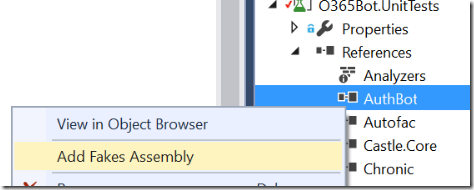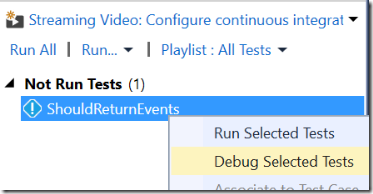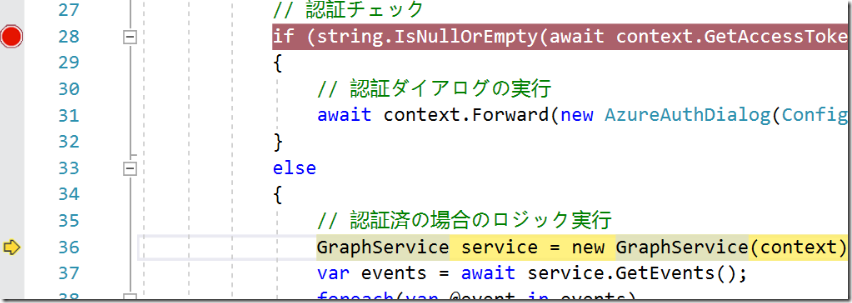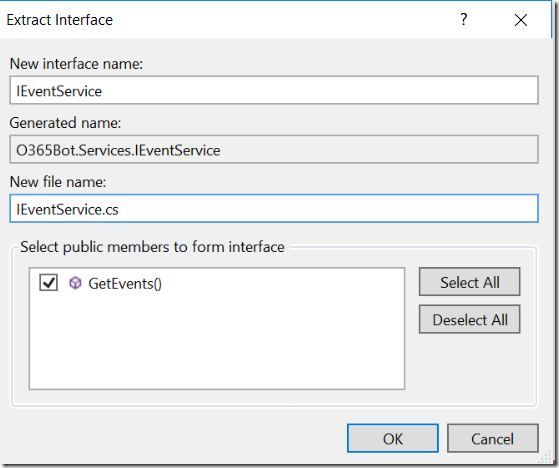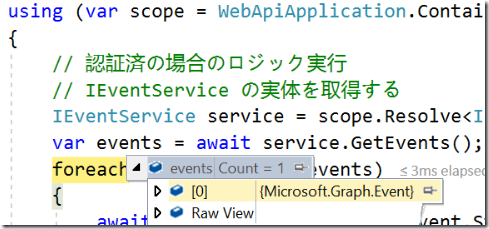Bot Framework と Microsoft Graph で DevOps その 4 : Microsoft Fakes, AutoFac, Moq で依存サービスのモック化
前回は AuthBot と Microsoft Graph を呼べるようにしました。今回は変更したものをユニットテストしてみます。
依存サービスのモック
依存サービスはモックを作り、常に意図した動作をするようにすることで、本当にテストしたい部分のユニットテストを行います。AuthBot と GraphService それぞれモック化します。
AuthBot のモック化
コード内で AuthBot の GetAccessToken メソッドを実行して、OAuth 2.0 のアクセストークンを取得していますが、ここをモック化します。ソースコードを見ると GetAccessToken は静的な部分メソッドですので、Microsoft Fakes を使います。Fakes の詳細はこちら。
1. Fake アセンブリを作るため、ユニットテストプロジェクトにも AuthBot を追加して、各種 NuGet パッケージを最新に更新します。
2. AuthBot 参照を右クリックして、Fakes Assembly を追加します。
3. UnitTest1.cs の ShouldReturnCount メソッドを削除して、以下のように書き換えます。
[TestMethod]
public async Task ShouldReturnEvents()
{
// Fakes を使うためにコンテキストを作成
using (ShimsContext.Create())
{
// AuthBot の GetAccessToken メソッドを実行した際、dummyToken というトークンが返るよう設定
AuthBot.Fakes.ShimContextExtensions.GetAccessTokenIBotContextString =
async (a, e) => { return "dummyToken"; };
// テストしたいダイアログのインスタンス作成
IDialog rootDialog = new RootDialog();
// Bot に送るメッセージを作成
var toBot = DialogTestBase.MakeTestMessage();
toBot.From.Id = Guid.NewGuid().ToString();
toBot.Text = "get appointments";
// メモリ内で実行できる環境を作成
Func<IDialog> MakeRoot = () => rootDialog;
using (new FiberTestBase.ResolveMoqAssembly(rootDialog))
using (var container = Build(Options.MockConnectorFactory | Options.ScopedQueue, rootDialog))
{
// メッセージを送信して、結果を受信
IMessageActivity toUser = await GetResponse(container, MakeRoot, toBot);
// 結果の検証
Assert.IsTrue(toUser.Text.Equals("You sent hi! which was 3 characters"));
}
}
}
4. RootDialog.cs の 認証チェックのコードあたりにブレークポイントを置きます。
5. 一旦ソリューションをコンパイルして、テストエクスプローラーより ShouldReturnEvents テストをデバッグ実行します。
6. ブレークポイントがヒットしたらステップ実行して、認証済ロジックに遷移することを確認します。
これで AuthBot の依存は解決しました。
GraphService のモック化
AuthBot と違いソースをもっているので、サービスをインターフェース化して、Moq と AutoFac を使います。
Moq の詳細はこちら。
AutoFac の詳細はこちら。
1. GraphService.cs を開き、GraphService からインターフェースを作成します。
2. インターフェース名は IEventService としました。
3. 次に AutoFac のセットアップをします。Global.asax.cs の中身を以下に差し替えます。IEventService を利用する際、GraphService を返します。
using Autofac;
using O365Bot.Services;
using System.Configuration;
using System.Web.Http;
namespace O365Bot
{
public class WebApiApplication : System.Web.HttpApplication
{
public static IContainer Container;
protected void Application_Start()
{
GlobalConfiguration.Configure(WebApiConfig.Register);
AuthBot.Models.AuthSettings.Mode = ConfigurationManager.AppSettings["ActiveDirectory.Mode"];
AuthBot.Models.AuthSettings.EndpointUrl = ConfigurationManager.AppSettings["ActiveDirectory.EndpointUrl"];
AuthBot.Models.AuthSettings.Tenant = ConfigurationManager.AppSettings["ActiveDirectory.Tenant"];
AuthBot.Models.AuthSettings.RedirectUrl = ConfigurationManager.AppSettings["ActiveDirectory.RedirectUrl"];
AuthBot.Models.AuthSettings.ClientId = ConfigurationManager.AppSettings["ActiveDirectory.ClientId"];
AuthBot.Models.AuthSettings.ClientSecret = ConfigurationManager.AppSettings["ActiveDirectory.ClientSecret"];
var builder = new ContainerBuilder();
builder.RegisterType<GraphService>().As<IEventService>();
Container = builder.Build();
}
}
}
4. RootDialog.cs ファイルの認証済ロジック内を以下のコードをに差し替えます。これにより実行時に動的にサービスをの実装を取得できます。
using (var scope = WebApiApplication.Container.BeginLifetimeScope())
{
// 認証済の場合のロジック実行
// IEventService の実体を取得する
// コンストラクタに IDialog context を渡す
IEventService service = scope.Resolve<IEventService>(new TypedParameter(typeof(IDialogContext), context));
var events = await service.GetEvents();
foreach (var @event in events)
{
await context.PostAsync($"{@event.Start.DateTime}-{@event.End.DateTime}: {@event.Subject}");
}
}
5. ユニットテストプロジェクトに戻って、Microsoft.Graph NuGet パッケージを追加します。
6. UnitTest1.cs を開き、以下 using を追加します。
using Moq;
using Microsoft.Graph;
7. ShouldReturnEvents テストメソッド、IDialog rootDialog = new RootDialog(); の前に以下のコードを追加します。これでテスト時にはモックのサービスを利用します。
// サービスのモック
var mockEventService = new Mock<IEventService>();
mockEventService.Setup(x => x.GetEvents()).ReturnsAsync(new List<Event>()
{
new Event
{
Subject = "dummy event",
Start = new DateTimeTimeZone()
{
DateTime = "2017-05-31 12:00",
TimeZone = "Standard Tokyo Time"
},
End = new DateTimeTimeZone()
{
DateTime = "2017-05-31 13:00",
TimeZone = "Standard Tokyo Time"
}
}
});
// IEventService 解決時にモックが返るよう設定
var builder = new ContainerBuilder();
builder.RegisterInstance(mockEventService.Object).As<IEventService>();
WebApiApplication.Container = builder.Build();
8. 先ほどと同じようにテストをデバッグ実行。指定したダミーのイベントが取得されていることを確認。
テストの改修
全てモック化できたので、最後にテストの検証個所を書き換えてテストしましょう。
1. 結果検証を以下のコードに差し替え。
// 結果の検証
Assert.IsTrue(toUser.Text.Equals("2017-05-31 12:00-2017-05-31 13:00: dummy event"));
2. テストエクスプローラーよりテストの実行。
3. テストが成功することを確認。
まとめ
今回は依存サービスのモック化を実施しました。次回は VSTS 側での CI を設定します。コードはすべてチェックインしておいてください。
